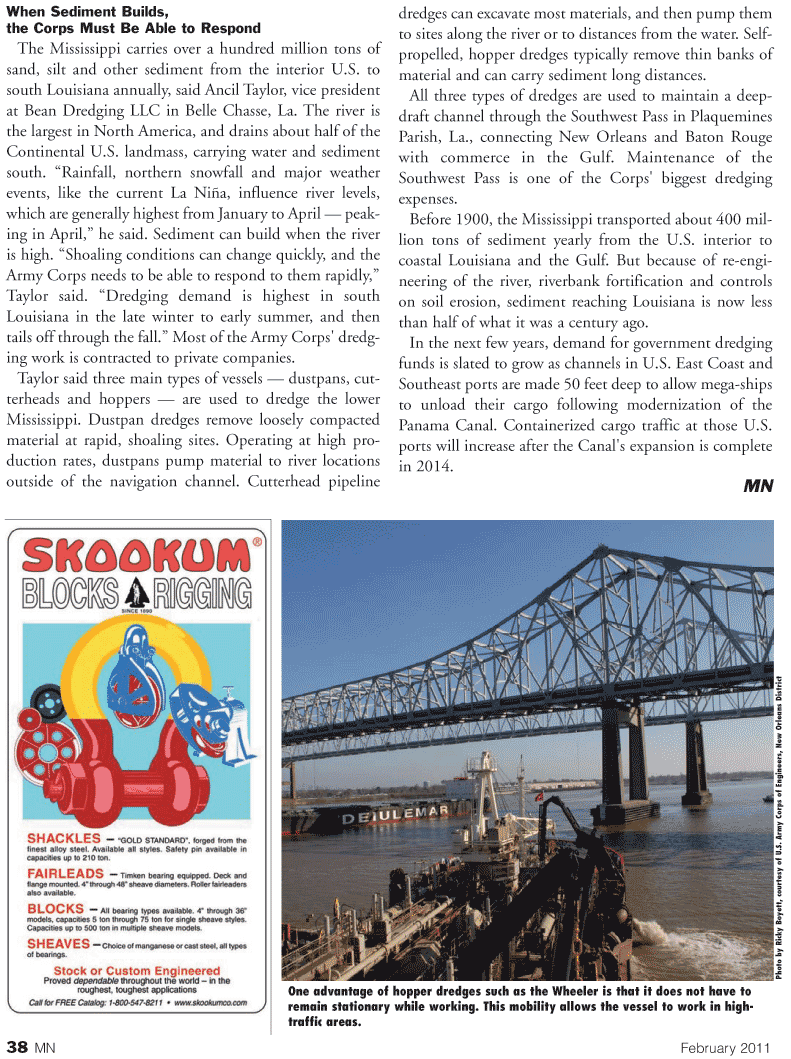
Page 38: of Marine News Magazine (February 2011)
Inland Waterways
Read this page in Pdf, Flash or Html5 edition of February 2011 Marine News Magazine
38 MN February 2011
When Sediment Builds, the Corps Must Be Able to Respond
The Mississippi carries over a hundred million tons of sand, silt and other sediment from the interior U.S. to south Louisiana annually, said Ancil Taylor, vice president at Bean Dredging LLC in Belle Chasse, La. The river is the largest in North America, and drains about half of the
Continental U.S. landmass, carrying water and sediment south. “Rainfall, northern snowfall and major weather events, like the current La Niña, influence river levels, which are generally highest from January to April — peak- ing in April,” he said. Sediment can build when the river is high. “Shoaling conditions can change quickly, and the
Army Corps needs to be able to respond to them rapidly,”
Taylor said. “Dredging demand is highest in south
Louisiana in the late winter to early summer, and then tails off through the fall.” Most of the Army Corps' dredg- ing work is contracted to private companies.
Taylor said three main types of vessels — dustpans, cut- terheads and hoppers — are used to dredge the lower
Mississippi. Dustpan dredges remove loosely compacted material at rapid, shoaling sites. Operating at high pro- duction rates, dustpans pump material to river locations outside of the navigation channel. Cutterhead pipeline dredges can excavate most materials, and then pump them to sites along the river or to distances from the water. Self- propelled, hopper dredges typically remove thin banks of material and can carry sediment long distances.
All three types of dredges are used to maintain a deep- draft channel through the Southwest Pass in Plaquemines
Parish, La., connecting New Orleans and Baton Rouge with commerce in the Gulf. Maintenance of the
Southwest Pass is one of the Corps' biggest dredging expenses.
Before 1900, the Mississippi transported about 400 mil- lion tons of sediment yearly from the U.S. interior to coastal Louisiana and the Gulf. But because of re-engi- neering of the river, riverbank fortification and controls on soil erosion, sediment reaching Louisiana is now less than half of what it was a century ago.
In the next few years, demand for government dredging funds is slated to grow as channels in U.S. East Coast and
Southeast ports are made 50 feet deep to allow mega-ships to unload their cargo following modernization of the
Panama Canal. Containerized cargo traffic at those U.S. ports will increase after the Canal's expansion is complete in 2014.
MN
One advantage of hopper dredges such as the Wheeler is that it does not have to remain stationary while working. This mobility allows the vessel to work in high- traffic areas.
Photo by Ricky Boyett, courtesy of U.S. Army Corps of Engineers, New Orleans District

 37
37

 39
39
